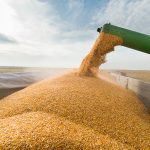Chicago | Reuters—Chicago soybean futures gained strength on Wednesday from a weaker dollar and a report that China would be open to trade negotiations with the U.S., though big supplies from South America and nearly nonexistent Chinese demand for U.S. beans continued to loom over the market, analysts said.
Corn and wheat futures rose, also supported by a renewed weakening of the U.S. dollar, which makes U.S. exports more competitive.
The most-active soybean contract on the Chicago Board of Trade Sv1 settled up 2-3/4 cents to $10.38-3/4 per bushel.
Read Also

U.S. livestock: Cattle fall sharply as Trump says he’s working to lower beef costs
Chicago cattle futures fell sharply on Friday after U.S. President Donald Trump said his administration was working to lower the…
CBOT July corn Cv1 rose 2-1/4 cents to $4.91-3/4 a bushel and July wheat Wv1 settled up 5 cents to $5.61 per bushel.
The dollar index moved back toward three-year lows reached after U.S. President Donald Trump announced his tariff policies.
China, by far the biggest buyer of U.S. soybeans, has imposed retaliatory tariffs on the United States that will make it expensive to import U.S. crops.
However, bearishness from the ongoing trade war has already been factored into the market, analysts said. A Bloomberg report on Wednesday stating that the Chinese government would be open to trade talks created positive market sentiment and added strength to soybean futures.
“It’s raising optimism that maybe trade negotiations can start sooner rather than later,” Randy Place, an analyst at Hightower Report, said.
Excess rain and flooding in the U.S. Midwest have slowed corn planting and added support to corn futures.
“For corn this year with acreage expected to be higher, farmers want to get an early start so they can get all their acres in,” Place said.
The rain has also drenched spring wheat in the same area, counterbalancing pressure from weather forecasts predicting much-needed rain in the coming days to the hard red winter wheat crop in the U.S. Plains.
—Additional reporting by Peter Hobson in Canberra and Sybille de La Hamaide in Paris














